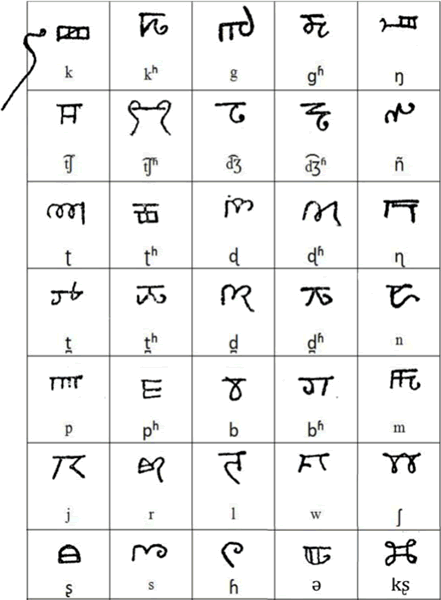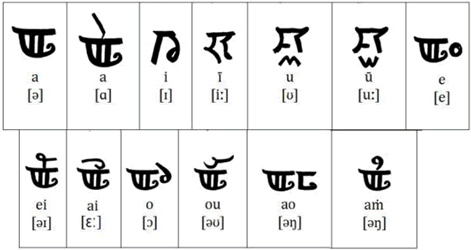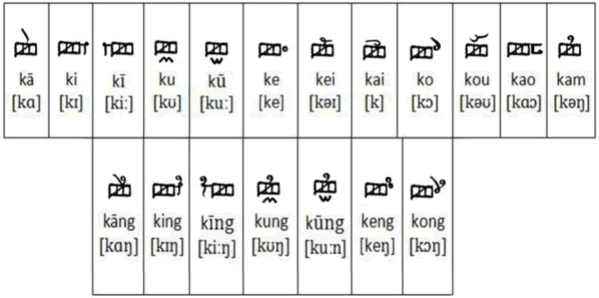The Old Manipuri script was used to write Manipuri from about the 11th century until the 18th century. After that it was replaced with the Bengali script. During the 1940s and 50s, Manipuri scholars began campaigning to bring back the Old Manipuri script. In 1976 at a writers conference, all the scholars agreed on a new version of the alphabet containing a number of additional letters to represent sounds not present in the language when the script was first developed. The current Meitei / Manipuri script is a reconstruction of the old Manipuri script.

In order to represent a vowel other than /ə/, Meithei Mayek follows other Brahmi-derived scripts by adding diacritical marks around the letter to modify the inherent vowel. One notable difference with Indic scripts but similarity with Tibetan is how vowels at the beginning of words are represented. In Indic scripts, there is a different letter for each word-initial vowel. However, in Meithei, there is a single letter to denote word-initial vowel, and diacritical marks are added to it to change it into another vowel.

Note that there are seemingly two letters for /i/ and also two for /u/. In reality, they represent the sounds /i/ and /u/ in two different tones. Meithei is a Tibeto-Burman language and has tones typical of many languages in that family. However, the representation of tones in the Meithei script is not complete. Tones are denoted only in a few cases (such as this), and often disambiguation of which tone is intended can only be achieved by context of the sentence.

Source: G.H. Dament, (1877) Journal of Asiatic Society of Bengal. Vol. XLVI Part-1

Information about the Manipuri scripts and pronunciation compiled and corrected by Wolfram Siegel and Athouba Chingakham.
Information about Manipuri | Manpuri script (Modern) | Manpuri script (Old) | Meetei Yelhou Mayek | Phrases | Numbers
Information about Manipuri
https://en.wikipedia.org/wiki/Meitei_script
https://www.endangeredalphabets.net/alphabets/meitei-mayek/
Ahom, Aima, Arleng, Badagu, Badlit, Basahan, Balinese, Balti-A, Balti-B, Batak, Baybayin, Bengali, Bhaiksuki, Bhujimol, Bilang-bilang, Bima, Blackfoot, Brahmi, Buhid, Burmese, Carrier, Chakma, Cham, Cree, Dehong Dai, Devanagari, Dham Lipi, Dhankari / Sirmauri, Ditema, Dives Akuru, Dogra, Ethiopic, Evēla Akuru, Fox, Fraser, Gond, Goykanadi, Grantha, Gujarati, Gunjala Gondi, Gupta, Gurmukhi, Halbi Lipi, Hanifi, Hanuno'o, Hočąk, Ibalnan, Incung, Inuktitut, Jaunsari Takri, Javanese, Kaithi, Kadamba, Kamarupi, Kannada, Kawi, Kharosthi, Khema, Khe Prih, Khmer, Khojki, Khudabadi, Kirat Rai, Kōchi, Kodava Lipi, Komering, Kulitan, Kurukh Banna, Lampung, Lanna, Lao, Lepcha, Limbu, Lontara/Makasar, Lota Ende, Magar Akkha, Mahajani, Malayalam, Meitei (Modern), Manpuri (Old), Marchen, Meetei Yelhou Mayek, Meroïtic, Masarm Gondi, Modi, Mon, Mongolian Horizontal Square Script, Multani, Nandinagari, Newa, New Tai Lue, Ojibwe, Odia, Ogan, Pahawh Hmong, Pallava, Phags-pa, Purva Licchavi, Qiang / Rma, Ranjana, Rejang (Kaganga), Sasak, Savara, Satera Jontal, Shan, Sharda, Sheek Bakrii Saphaloo, Siddham, Sinhala, Sorang Sompeng, Sourashtra, Soyombo, Sukhothai, Sundanese, Syloti Nagri, Tagbanwa, Tai Noi, Takri, Tamil, Tanchangya (Ka-Pat), Tani, Thaana, Telugu, Thai, Tibetan, Tigalari, Tikamuli, Tocharian, Tolong Siki, Vatteluttu, Warang Citi
Page last modified: 16.03.23
[top]
You can support this site by Buying Me A Coffee, and if you like what you see on this page, you can use the buttons below to share it with people you know.

If you like this site and find it useful, you can support it by making a donation via PayPal or Patreon, or by contributing in other ways. Omniglot is how I make my living.
Note: all links on this site to Amazon.com, Amazon.co.uk
and Amazon.fr
are affiliate links. This means I earn a commission if you click on any of them and buy something. So by clicking on these links you can help to support this site.
[top]